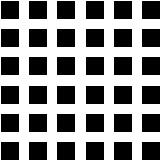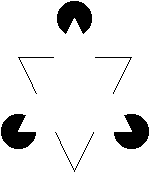

Figure 15: Optical Illusions









Figure 15: Optical Illusions
The left illusion induces the illusion of gray values in the eye that the brain "knows" does not exist. Further, there is a sense of dynamic change in the image due, in part, to the saccadic movements of the eye. The right illusion, Kanizsa's triangle, shows enhanced contrast and false contours neither of which can be explained by the system-oriented aspects of visual perception described above.
